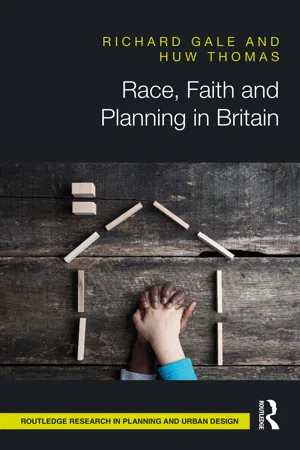![]()
1 Introduction
The Terrain of Race and Planning
In Britain as elsewhere, we are living through an era of deep, and seemingly deepening, contradiction with regards to the politics of race. Until relatively recently, a casual observer of the post-World War II history of British race relations could have been forgiven for concluding that many of the most overt challenges of racism and institutional discrimination faced by migrants and minorities in the final decades of the twentieth century had, at least partially, retreated from the political scene. Admittedly, such a conclusion might have said more about the sheer magnitude of racism in the early years of British post-war reconstruction than about the extent of progressive change that has taken place since. As we discuss in detail in Chapter 4, during the 1960s and 1970s, when migration from Britain’s former colonial territories was still in full flow, exclusionary racial discourses were conspicuous in the functioning of many public policy fields, including migration, housing, policing, education and employment, and there was a correlatively high degree of tolerance for unconcealed racial thinking within key sections of the British political class, at both local and national levels (Rose, 1969). As a consequence, building in part on comparable work undertaken in the US (notably Myrdal, 1996 [1944]), critical race relations scholarship was at pains to point out the overt disparity and dissonance between the much-vaunted British values of tolerance, liberty and ‘fair play’ on the one hand, and the extent of pronounced, structured disadvantage experienced by Britain’s emerging minority ethnic populations on the other (see especially the work of Rex and Moore, 1967; Rose, 1969; Rex and Tomlinson, 1979). Against this, in the intervening years, while progress has been far from linear, there have been important milestones in alleviating some of the more acute expressions of racism in Britain, most of them achieved through the concerted political mobilisation of racialised minorities. As we explore later, a number of these are of direct relevance to the theme of this book. For instance, in the mid-1970s, powerful anti-discrimination legislation in the form of the 1976 Race Relations Act significantly extended earlier, more rudimentary race discrimination legislation, to cover not only obvious, ‘direct’ forms of racism, but also subtler, ‘indirect’ forms that manifest themselves in the workings of the policies and practices of public bodies. (This Act has since been superseded by broader, multi-stranded anti-discrimination legislation in the form of the 2010 Equality Act, which brings all forms of discrimination within its scope according to a range of ‘protected characteristics’ that include age, disability, gender assignment, marriage or civil partnership, pregnancy and maternity, race, religion or belief, and sex.) Another important milestone of relevance to our theme was the publication of the Stephen Lawrence Inquiry report (also known, and referred to hereafter as the ‘Macpherson Report’) (Macpherson, 1999), which concluded a major inquiry into the police investigation of the murder of Black teenager Stephen Lawrence in 1993, giving renewed urgency and political salience to the concept of institutional racism within UK public bodies.
Nevertheless, these and other milestones notwithstanding, there is strong evidence to suggest that recent political events and processes in the UK have resulted in key elements of the settlement concerning racial equality and inter-ethnic tolerance, achieved fitfully over the previous three to four decades, being called into question. The contradiction alluded to above thus lies in the fact that, while still formally committed to an ethics of equality and anti-discrimination as enshrined in law and policy, recently the apparent alignment between anti-racist ethics on the one hand and political will and popular opinion on the other, has undergone a number of serious set-backs, with far-reaching implications. As a fairly stark indication of the changed climate, official research reveals a colossal rise in reported incidents of racially motivated hate crimes in England and Wales in recent years, from 35,944 in 2011/2012 to 71,251 in 2017/2018 – an increase of 98 per cent across the period (Home Office, 2018). Yet more striking, the increase in recorded hate crime on grounds of religion has increased from 1,614 to 8,336 incidents over the same time period – an increase of 415 per cent. While the report states that this increase is likely to be accounted for in part by improvements to police reporting, it also frankly acknowledges the impact of ‘spikes in hate crime following certain events such as the EU referendum and the terrorist attacks in 2017’ (Home Office, 2018: 7). Other recent policy developments tell a correspondingly bleak story of the resurgence of racialisation within the UK, in ways that link together both popular and institutional political expressions. Among the more salient of these was the Home Office’s introduction of an explicit ‘hostile environment’ policy (also known as the ‘compliant environment’ policy) on immigration, announced initially by the then Home Secretary Theresa May in 2012 and subsequently enshrined in the 2014 Immigration Act (Bolt, 2016). As clearly stated in Government documentation, this policy was premised on a concerted attempt to foster a culture of hostility towards migrants without leave to remain in the UK, with the aim of prompting migrants’ voluntary departure from the country (Broomfield, 2017; House of Commons, 2019). As we outline in Chapter 4, while migration has long been a focus of political contention, the hostile environment agenda provides a stark illustration of the regressive drift of UK immigration policy in recent years.
However, through its application in practice, the hostile environment policy came to have yet more extensive implications than the immediate ones it was intended to have for ‘illegal’ migrants, significant though these have demonstrably been (House of Commons, 2019). It is worth considering these implications more fully, in that they illustrate palpably a core argument of this book, namely that achievements made in the field of racial equality, although invariably hard-fought, are often highly provisional, and frequently subject to reversals when the social and political conditions that facilitated them ...
